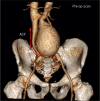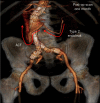Aortocaval fistula, a potentially favourable complication of abdominal aortic aneurysm rupture in endovascular repair
- PMID: 32436721
- PMCID: PMC7538739
- DOI: 10.1308/rcsann.2020.0090
Aortocaval fistula, a potentially favourable complication of abdominal aortic aneurysm rupture in endovascular repair
Abstract
Endovascular aneurysm repair is an established treatment for ruptured abdominal aortic aneurysm. Primary aortocaval fistula is an exceedingly rare finding in ruptured abdominal aortic aneurysm, with a reported incidence of less than 1%. The presence of an aortocaval fistula used to be an unexpected finding in open surgical repair which often resulted in massive haemorrhage and caval injury. We present a case of ruptured abdominal aortic aneurysm with an aortocaval fistula that was successfully treated with percutaneous endovascular aneurysm repair under local anaesthesia. Despite a persistent type 2 endoleak the aneurysm sack shrank from 8.4cm to 4.8cm in 12 months. The presence of an aortocaval fistula may have depressurised the aneurysm, resulting in less bleeding retroperitoneally and may have promoted rapid shrinkage of the sac despite the presence of a persistent type 2 endoleak.
Keywords: Aortic aneurysm; Aortic rupture; Aortocaval fistula; Percutaneous EVAR; Type 2 endoleak.
Figures





Similar articles
-
Aneurysm Shrinkage Is Compatible With Massive Endoleak in the Presence of an Aortocaval Fistula: Potential Therapeutic Implications for Endoleaks and Spinal Cord Ischemia.J Endovasc Ther. 2016 Jun;23(3):529-32. doi: 10.1177/1526602816638834. Epub 2016 Mar 17. J Endovasc Ther. 2016. PMID: 26988745
-
Emergent Endovascular Repair of Challenging Aortocaval Fistula With Hostile Anatomy.Vasc Endovascular Surg. 2017 Jul;51(5):255-260. doi: 10.1177/1538574417701323. Epub 2017 May 9. Vasc Endovascular Surg. 2017. PMID: 28486843
-
Total endovascular management of ruptured aortocaval fistula: technical challenges and case report.Vascular. 2014 Aug;22(4):306-9. doi: 10.1177/1708538113499018. Epub 2013 Sep 2. Vascular. 2014. PMID: 24000081
-
Aortocaval fistula treated by aortic exclusion.J Vasc Surg. 1995 Nov;22(5):639-42. doi: 10.1016/s0741-5214(95)70053-6. J Vasc Surg. 1995. PMID: 7494369 Review.
-
[An inflammatory aortic aneurysm ruptured into the retroperitoneum and an extensive communication of the aneurysm with the vena cava inferior].Angiologia. 1993 Sep-Oct;45(5):166-9. Angiologia. 1993. PMID: 8285362 Review. Spanish.
Cited by
-
Staged triple endovascular approach for repair of aortocaval fistula secondary to ruptured abdominal aortic aneurysm.J Vasc Surg Cases Innov Tech. 2023 Sep 27;9(4):101335. doi: 10.1016/j.jvscit.2023.101335. eCollection 2023 Dec. J Vasc Surg Cases Innov Tech. 2023. PMID: 38023326 Free PMC article.
-
Endovascular repair for arterio-venous fistula treatment: a case report.Gen Thorac Cardiovasc Surg Cases. 2023 Aug 11;2(1):82. doi: 10.1186/s44215-023-00088-5. Gen Thorac Cardiovasc Surg Cases. 2023. PMID: 39516869 Free PMC article.
-
Duplex Ultrasound of the Femoral Vein for Monitoring Endovascular Treatment of Aortocaval Fistula: A Case Report.Vasc Specialist Int. 2024 Dec 16;40:39. doi: 10.5758/vsi.240082. Vasc Specialist Int. 2024. PMID: 39675887 Free PMC article.
-
A Rare Complication of Abdominal Aortic Aneurysm: A Case Report of Aortocaval Fistula.Cureus. 2023 Apr 25;15(4):e38106. doi: 10.7759/cureus.38106. eCollection 2023 Apr. Cureus. 2023. PMID: 37252494 Free PMC article.
-
Incidental aortocaval fistula in the setting of an unruptured abdominal aortic aneurysm.J Surg Case Rep. 2023 Jul 3;2023(7):rjad384. doi: 10.1093/jscr/rjad384. eCollection 2023 Jul. J Surg Case Rep. 2023. PMID: 37416494 Free PMC article.
References
-
- IMPROVE Trial Investigators, Powell JT, Sweeting MJ, Thompson MM et al. . Endovascular or open repair strategy for ruptured abdominal aortic aneurysm: 30 day outcomes from IMPROVE randomised trial. BMJ 2014; : f7661. - PubMed
-
- Adili F, Balzer JO, Ritter RG et al. . Ruptured abdominal aortic aneurysm with aorto-caval fistula. J Vasc Surg 2004; : 582. - PubMed
-
- Ala-Ketola L, Karkola P, Koivisto E. Aorto-caval fistula as complication of abdominal aortic aneurysm. Rofo 1978; : 93–94. - PubMed
-
- Reckless JP, McColl I, Taylor GW. Aorto-caval fistulae: an uncommon complication of abdominal aortic aneurysms. Br J Surg 1972; : 461–462. - PubMed
-
- Schmidt R, Bruns C, Walter M, Erasmi H. Aorto-caval fistula: an uncommon complication of infrarenal aortic aneurysms. Thorac Cardiovasc Surg 1994; : 208–211. - PubMed
Publication types
MeSH terms
LinkOut - more resources
Full Text Sources

